Eliel Saarinen's Tribune Tower design
| Eliel Saarinen's Tribune Tower design | |
|---|---|
 Eliel Saarinen's unbuilt 1922 skyscraper design | |
| Alternative names | Saarinen tower |
| General information | |
| Status | Never built |
| Type | Commercial offices |
| Technical details | |
| Floor count | 29 |
| Lifts/elevators | 12 |
| Design and construction | |
| Architect | Eliel Saarinen |
Eliel Saarinen's Tribune Tower design or the Saarinen tower are terms used to describe the unnamed and unbuilt design for a modernist skyscraper, created by Finnish architect Eliel Saarinen and submitted in 1922 for the Chicago Tribune 's architectural competition for a new headquarters. The winning entry, the neo-Gothic Tribune Tower, was built in 1925. Saarinen's entry came in second place yet became influential in the design of a number of future buildings.
Background
In 1921–22, the prominent Tribune Tower competition was held to design a new headquarters for the Chicago Tribune, a major US metropolitan newspaper. It attracted 260 entries. First place was awarded to a design by New York architects John Mead Howells and Raymond Hood, a neo-Gothic building completed in 1925. Saarinen was awarded $20,000 for second place; his design was never constructed.[1] Many observers felt that Saarinen's simplified yet soaring setback tower was the most appropriate entry, and his novel modernist design influenced many subsequent architectural projects.[2][3]
Saarinen was a veteran architect but had never before designed a skyscraper. To arrive at his noteworthy design, he took as a starting place the upward sweep of Gothic architecture, but then advanced this sense of verticality as his primary design principle. He said that through "logical construction" each portion of the design was made to reflect the larger goal of verticality.[4] He was 49 years old when he submitted the design; the next year he moved from Finland to the Chicago area. In the U.S., he contributed to an overall design for the Chicago lakefront, and he lectured at the University of Michigan, but none of his skyscraper designs were ever built. Instead, others found success by incorporating his vision. Tribune Tower competition co-winner Raymond Hood adopted Saarinen's skyscraper style for several of his subsequent projects,[5] and Saarinen's design was emulated by other contemporary architects such as Timothy L. Pflueger, George W. Kelham, Hubbell and Benes, Holabird & Roche, Alfred C. Finn, and James Edwin Ruthven Carpenter, Jr., as well as later architect César Pelli.[6]
Reception
Respected Chicago architect Louis Sullivan offered high praise to Saarinen's design, and said that his building indicated the future direction for the old Chicago School. Sullivan named Saarinen his stylistic successor. Chicago architects Thomas Tallmadge and Irving Kane Pond were also very vocal in their praise for Saarinen. Pond said Saarinen's design was by far the best contest entry, that it was devoid of the superficial adornments featured on the winning entry, and free of the "stranglehold of conventional forms."[4] Tallmadge projected that Saarinen's design would be transformative for American skyscrapers.[7] He said that under Saarinen's hand, the spirit of the skyscraper, "rid of its inhibitions and suppressed desires... leaps in joyous freedom to the sky."[8]
Skyscraper Museum director Carol Willis, and art consultant Franck Mercurio, curator at the Field Museum in Chicago, offer moderating modern views about the influence of Saarinen's design. Willis notes that setback architecture was being implemented in New York City highrises because of 1916 zoning ordinances related to building height and sunlight, and that Saarinen's design was understood to be an embodiment of this trend.[9] Mercurio points to the Tribune Tower competition entry from American architect Bertram Goodhue as having the same modernist features as Saarinen's, with dramatic setbacks but a more pronounced simplification of the exterior. Mercurio argues that Goodhue's design is a better example of modernism because it has less ornamentation. Goodhue's entry gained him honorable mention but no cash award.[10]
Buildings influenced
The following buildings have been observed to be influenced by Saarinen's 1922 design.
| Name | Image | Location | Architect | Floors | Year | Notes |
|---|---|---|---|---|---|---|
| American Radiator Building |  | New York City | Raymond Hood | 23 | 1924 | The American Radiator Building was the next commission by Raymond Hood following his success in the Tribune Tower competition. Hood quickly adapted Saarinen's style and applied it to this design, which was finished with construction before the Tribune Tower was completed.[5][11] |
| 140 New Montgomery |  | San Francisco | Timothy L. Pflueger | 26 | 1925 | Originally called the Pacific Telephone & Telegraph Building, 140 New Montgomery was designed by San Francisco architect Timothy L. Pflueger in 1923–1924 to be the headquarters for Pacific Telephone & Telegraph. The 26-story building, completed in 1925, was the tallest in San Francisco for 40 years, in a close tie with the Russ Building. Pflueger's vision for the building lay in combining the vertical thrust of Saarinen with the reflective qualities of Sierra granite.[12] |
| Russ Building | San Francisco | George Kelham | 32 | 1927 | The Russ Building was designed by architect George Kelham. The 32-story building, completed in 1927, was the tallest in San Francisco for 38 years, in a close tie with 140 New Montgomery.[12] | |
| AT&T Huron Road Building | 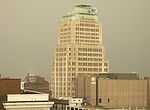 | Cleveland | Hubbell and Benes | 24 | 1927 | Originally known as the Ohio Bell Huron Building, the skyscraper served as offices and a regional switching center for telephone company Ohio Bell. The building was designed by Hubbell and Benes with a perpendicular modernist vision following Saarinen's lead.[13] |
| 333 North Michigan | Chicago | Holabird & Root, John Wellborn Root, Jr. | 34 | 1928 | John Wellborn Root, Jr. designed the exterior of this commercial skyscraper, keeping to the clean verticality of Saarinen's design.[14] | |
| Fisher Building |  | Detroit | Albert Kahn Associates, Joseph Nathaniel French | 30 | 1928 | The Fisher Building was built across the street from the headquarters of General Motors (GM) to house the offices of Fisher Body which had been acquired in 1926 by GM. Joseph Nathaniel French of Albert Kahn Associates served as the chief architect. French's hand is strongly evident, taking his inspiration from Saarinen's clean vertical lines; the building is unlike other Albert Kahn works.[15] |
| JPMorgan Chase Building (Houston) | 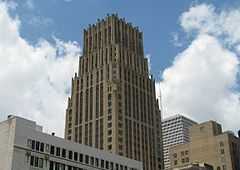 | Houston | Alfred C. Finn, Kenneth Franzheim, and J. E. R. Carpenter | 36 | 1929 | Originally known as the Gulf Building and built to house the offices of Gulf Oil, National Bank of Commerce, and the Sakowitz brothers, the building was commissioned by Texas politician and entrepreneur Jesse H. Jones.[16] Its stepped profile was based on Saarinen's 1922 design.[17] Later it was known as the Texas Commerce Bank Building. It was the tallest building in Houston until 1963.[18] |
| David Stott Building |  | Detroit | Donaldson and Meier | 38 | 1929 | The David Stott Building is the tallest ever designed by Donaldson and Meier.[19] Verticality is emphasized by the near absence of ornamentation, and by a relatively small footprint which yields a slender profile. The building features a series of setbacks from the 23rd floor upward.[20] Michigan architecture professor Eric J. Hill of the American Institute of Architects wrote that the David Stott Building is a classic example of modernism, and that few Detroit skyscrapers "captured the ideal" of Saarinen's design so well.[21] |
| Seattle Tower |  | Seattle | Albertson, Wilson & Richardson | 27 | 1929 | The Seattle Tower was built as the Northern Life Tower, to serve as the headquarters for Northern Life Insurance Company. Architects Albertson, Wilson & Richardson took inspiration from Saarinen's vertically oriented design.[22] |
| Shell Building | 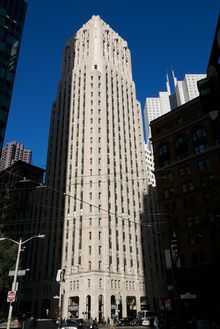 | San Francisco | George Kelham | 28 | 1929 | The Shell Building in San Francisco was designed by George Kelham. The 28-story building was completed in 1929. Kelham emphasized Gothic verticality; the top of the building is especially like Saarinen's design.[12][23] |
| Powhatan Apartments | Chicago | Leichenko & Esser, Charles L. Morgan | 22 | 1929 | The Powhatan is one of five apartment buildings financed in the late 1920s by the Garard Trust, designed by the architectural firm Leichenko & Esser, with Charles L. Morgan responsible for appearance. He was influenced largely by Saarinen's stripped-down exterior design incorporating unbroken vertical piers.[24] | |
| Daily News Building | 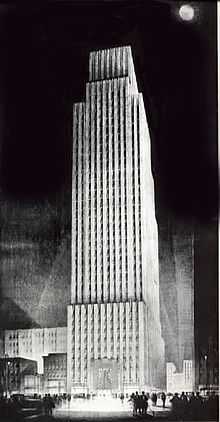 | New York City | John Mead Howells, Raymond Hood | 36 | 1930 | The New York Daily News headquarters is a modernist stepback building designed by Howells and Hood, the winners of the Tribune Tower competition. Though the exterior is mostly free from ornament, Howells and Hood embraced a more expressive Art Deco-style in their design of the interior, especially the lobby.[25] |
| McAllister Tower Apartments | 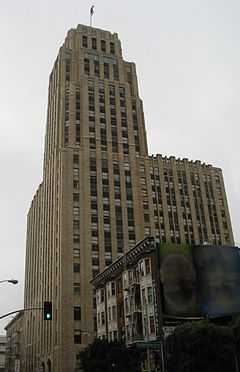 | San Francisco | Timothy L. Pflueger | 28 | 1930 | The McAllister Tower Apartments, originally the William Taylor Hotel, was designed by Timothy L. Pflueger for a church congregation. The 28-story building, completed in 1930, was initially an unusual combination of church at street level and hotel above it.[12] |
| Tower Petroleum Building | Dallas | Mark Lemmon | 23 | 1931 | Architect Mark Lemmon hewed closely to Saarinen's vision by implementing two setbacks.[26] | |
| 181 West Madison Street |  | Chicago | César Pelli | 50 | 1990 | Early in his career, César Pelli was a project designer under Eero Saarinen, the architect son of Eliel Saarinen. The strong verticality of 181 West Madison Street is emphasized by setbacks in the manner of the elder Saarinen.[6] |
References
- ↑ Douglas, George H. (2004). Skyscrapers: A Social History Of The Very Tall Building In America. McFarland. p. 78. ISBN 0786420308.
- ↑ Solomonson, Katharine (2003). The Chicago Tribune Tower Competition: Skyscraper Design and Cultural Change in the 1920s (2 ed.). University of Chicago Press. p. 245. ISBN 0226768007.
- ↑ Barkan, Elliott R. (2001). Making it in America: A Sourcebook on Eminent Ethnic Americans. ABC-CLIO. p. 328. ISBN 1576070980.
- ↑ 4.0 4.1 Solomonson 2003, p. 175.
- ↑ 5.0 5.1 Solomonson 2003, p. 247.
- ↑ 6.0 6.1 AIA Guide to Chicago 2004, p. 85.
- ↑ Solomonson 2003, p. 294.
- ↑ Solomonson 2003, p. 295.
- ↑ Willis, Carol (March 1986). "Zoning and Zeitgeist: The Skyscraper City in the 1920s". Journal of the Society of Architectural Historians 45 (1): 47–59. doi:10.2307/990128.
- ↑ Mercurio, Franck (November 6, 2011). "A tale of two skyscraper designs". Modern Before Mies. Retrieved April 22, 2013.
- ↑ Henry, Jay C. (1993). Architecture in Texas, 1895–1945. University of Texas Press. pp. 217–218. ISBN 0292730721.
- ↑ 12.0 12.1 12.2 12.3 Poletti, Therese; Tom Paiva (2008). Art Deco San Francisco: The Architecture of Timothy Pflueger. Princeton Architectural Press. pp. 62–65, 72, 106. ISBN 1-56898-756-0.
- ↑ Federal Writers Project (1940). The Ohio Guide. Best Books. p. 123. ISBN 1623760348.
- ↑ AIA Guide to Chicago 2004, p. 29
- ↑ Hitchcock, Henry-Russell (1977). Architecture: Nineteenth and Twentieth Centuries. Pelican History of Art 215 (4 ed.). Yale University Press. pp. 483–484. ISBN 0300053207.
- ↑ Gonzalez, J.R. (November 26, 2008). "Former Gulf Building gets high honor". Houston Chronicle.
- ↑ Victor, Sally S. "Gulf Building, Houston". Texas State Historical Association. Retrieved April 22, 2013.
- ↑ Fenberg, Steven (2011). Unprecedented Power: Jesse Jones, Capitalism, and the Common Good. Texas A&M University Press. p. 170. ISBN 1603445714.
- ↑ Korom, Joseph J., Jr. (2008). The American Skyscraper, 1850–1940: A Celebration of Height. Branden Books. p. 375. ISBN 0828321884.
- ↑ "David Stott Building, Donaldson & Meier, 1929". Preservation: Detroit Art Deco Highlights. Detroit Area Art Deco Society. Retrieved September 12, 2013.
- ↑ Hill, Eric J. (2003). AIA Detroit: The American Institute of Architects Guide to Detroit Architecture. Wayne State University Press. p. 78. ISBN 0814331203.
- ↑ "Northern Life Tower". Seattle: A National Register of Historic Places Travel Itinerary. National Park Service. Retrieved April 22, 2013.
- ↑ Wiley, Peter Booth (2000). National Trust Guide – San Francisco: America's Guide for Architecture and History Travelers. John Wiley & Sons. p. 161. ISBN 0471191205.
- ↑ Alice Sinkevitch, Laurie McGovern Petersen, ed. (2004). AIA Guide to Chicago (2 ed.). Houghton Mifflin Harcourt. p. 427. ISBN 0156029081.
- ↑ Reed, Henry H. (1971). The Golden City. W. W. Norton & Company. p. 142. ISBN 039300547X.
- ↑ Henry 1993, p. 314.
External links
- The Chicago Tribune Competition, Skyscraper Museum